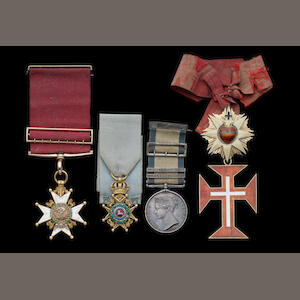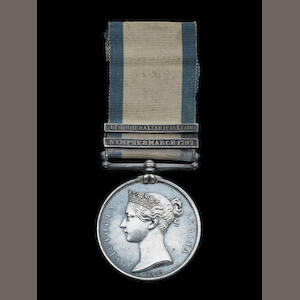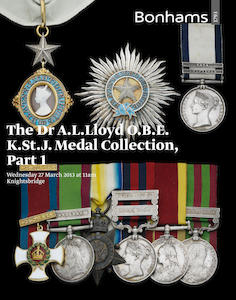Another thing I didn't blog about during my little hiatus was the latest batch of medal auctions from the 'Big Four'. On Monday and Tuesday of this week we had
DNW and on Wednesday
Bonhams.
DNW sales are always jam-packed full of goodies and, with over 1,200 lots, take two days to clear. It's always difficult to decide what to draw attention to when blogging on one of them. There were some very nice lifesaving medals, which are an interest of mine. Some were from the collection of John Wilson, an expert on the awards on the Society for the Preservation of Life from Fire (he literally wrote the book on the subject). One group of medals that jumped out at me wasn't from John's collection, but was to a bathing superintendent, Frank Shooter, who was credited with saving over 300 lives during a remarkable career. For some reason these were unsold - perhaps the estimate of £3,000-3,500 was just a little too rich when there was so much else on offer.
 |
| Launcelot Fleming's medals |
 |
| Bishop Launcelot Fleming |
Another group that appealed to me on several levels (except for the price!) was that to Launcelot Fleming. After studying geology and glaciology at Cambridge, he was ordained into the Church of England. Unusually, he was then invited to join expeditions to Iceland in 1932, Svalbard (Spitsbergen) in 1933, and then the British Graham Land Expedition to Antarctica, 1934-37. During the Second World War he was a naval chaplain, among other postings, serving on the battleship HMS
Queen Elizabeth. In 1949, despite having little parish experience, he was appointed Bishop of Portsmouth and, in 1959, Bishop of Norwich. After retiring from that diocese in 1971, he became Dean of Windsor (he officiated at the funeral of the Duke of Windsor). He died in 1990. I'm pleased to say that his medals have returned to Norfolk, where they will be held by a private collector.
In contrast to DNW, Bonham's sale consisted of a single collection (in fact, just Part I of the collection) - the Dr A L Lloyd Collection of medals to medical personnel.
It was a lovely selection of material and just went to show how collecting themes can over-lap, for there was something for everyone. There were medals from the Napoleonic Wars to modern conflicts; campaign awards; orders; gallantry awards; and long service medals. Although there were medals to doctors and nurses who served in the Army and Air Forces, I'll pick out a couple of early pieces to naval surgeons.
 |
| Sir George Magrath's medal group - £14,400 |
The item that caught press attention both before and after the sale was the lot to Horatio Nelson's personal surgeon, Sir George Magrath, which sold for £14,400. The long catalogue entry quoted from several of Nelson's letters, in which he described Magrath as 'the most able medical man I have seen' and 'Mr Magrath, whom I admire for his great abilities every day that I live'. He missed being with Nelson at Trafalgar as he was left in Gibraltar to assist with an outbreak of yellow fever. In later years he was Inspector of Hospitals and Fleets for the Royal Navy.
 |
Naval General Service Medal to Surgeon B F Outram
- an eye-watering £33,600. |
Less eye-catching, but rather more desirable to at least two collectors was the single Naval General Service Medal to Surgeon B F Outram. Although Outram (later Sir Benjamin Fonseca Outram KCB) had a distinguished career (he also was Inspector of Hospitals and Fleets), it is the numanistic aspects which are more important here than the 'man behind the medal'. The medal has the clasps 'Nymphe, 8th March 1797' and 'Gut of Gibraltar 12th July 1801'. The first clasp marks the engagement between HMS
San Fiorenzo (Capt Sir Harry Neale), HMS
Nymphe (Capt John Cooke) and the French ships
Résistance (Cmdre Jean-Baptiste Montagniés Laroque) and
Constance (Capt Desauney), who were returning from the farcical invasion of Pembrokeshire. The second was awarded for an action off Cadiz when Sir James Saumarez defeated the French and Spanish fleets in July
1801.
The significance of all this lies in the fact that the Naval General Service Medal wasn't awarded until 1847 and only to those surviving veterans who went through the application process. As a result, some of the early, 'single ship' clasps were only claimed by a very few men. Although 144 of the 'Gut of Gibratar' clasps were issued, there were only 5 of the 'Nymphe'. This is a unique combination. One knowledgeable collector of Naval General Service medals described this as a 'once in a lifetime' purchase. Oddly enough, there was no indication of this scarcity factor in Bonham's catalogue description. With an estimate of £5,000-7,000, the medal sold for an eye-watering £33,600 (inc premium).





No comments:
Post a Comment